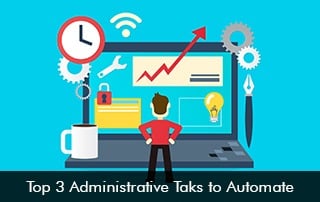As a healthcare provider, you are inclined towards taking care of patients and not focusing on administrative tasks. Unfortunately, operational errands and responsibilities can lead to physician burnout and increased stress levels. Daily administrative tasks also overwhelm staff members leading to additional pressure which can impact job performance levels. What can be done about these cumbersome tasks? Practices need to take quick responses by automating and digitizing workflows and daily processes to combat the issue of stress levels in the healthcare organization for a happy and fulfilling work environment.
Digital tools to streamline daily processes
The COVID-19 pandemic has accelerated the use of digital tools to provide services to patients which were traditionally done through one-on-one interactions. Hospital management has realized that embracing technology for automation will streamline administrative and clinical tasks which will allow staff members to focus on other important activities.
A study was conducted by CAQH which revealed that the US healthcare industry can reduce the cost of care by completely transitioning to electronic processes.
The commonly used digital tools to automate hospital tasks
- Electronic Medical Records (EMR) Software and EHR systems
- Computerized Physician Order Entry (CPOE)
- Clinical Decision Support Systems Tools
- Telemedicine Software
- PACS solutions
- Appointment Scheduling Software
- Patient Management Systems
- Revenue Cycle Management (RCM) Software solution
- Laboratory Information Management Systems (LIMS)
Key Activities and Operations to Digitize
The following daily administrative tasks can be automated through healthcare technology for workflow optimization and to keep staff burdens at bay.
- Patient Check-In Process – By automating the patient check-in process through robust check-in apps patients can easily check in before their appointment which saves time at the doctor’s office. Patient kiosk (EMR) Software also reduces patient wait times and staff members need not scan paper forms into the Electronic Medical Records (EMR) software system, this way staff can concentrate on other tasks to further improve their services. The check-in process is streamlined and also leads to an increase in return on investment.
- Patient and Provider Communication – Most patients don’t like calling and waiting on the phone to book an appointment or request a prescription refill. Practices should embrace the Patient-Portal EMR Software platform which links patients to providers round the clock through the facility of prompt two-way messaging. This frees up front desk staff time and messages can be sent easily to patients regarding any important notices. Personal birthday messages can also be sent to the patients easily. The HIPAA-compliant platform offers security and protection and patients feel comfortable sharing their confidential health information. This way the medical assistant doesn’t need to focus on faxes but on their usual duties which keep burdens at a minimum. Staff can work more efficiently and are satisfied to meet their daily work goals.
- Physician Documentation – Clinical documentation is one of the major reasons which can lead to physician burnout. To streamline the documentation process and decrease documentation time speech recognition tools in the EHR software can be leveraged. The speech recognition tools are highly accurate and also allow the provider to give undivided attention to the patient during an encounter which can improve health outcome levels. Some EMR software also utilizes Artificial Intelligence which converts patient and provider discussions into clinical notes to be positioned in the Electronic Health Records.
Better care with automation
By making these changes in your practice through embracing technology and healthcare software solutions practices will experience a boost in productivity levels which can, in turn, stimulate growth and profits. Digitizing admin tasks can make a big difference in efficiency levels as everyone working in the practice is focused on offering better care services.







